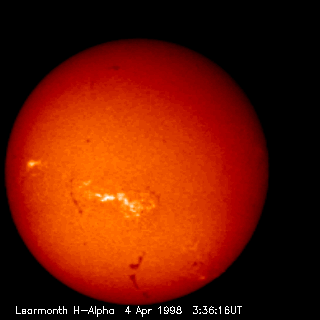Explanation: Our Sun changes every day. This recent picture was taken in a very specific red color called Hydrogen-Alpha. Dark spots that might appear on the image are usually sunspots, dark magnetic depressions that are slightly cooler than the rest of the Sun's surface. Bright spots that might appear are usually plages, active regions that are slightly hotter than the rest of the Sun's surface. Over the next few years the average number of sunspots and plages will increase until "Solar Maximum" occurs in 2001. The Sun usually goes through a maximum and minimum every 11 years. From 1645 to 1715, however, almost no sunspots at all were recorded, for reasons unknown. (An updated picture can be found here.)
1999 2000 2001 2002 2003 2004 2005 2006 2007 2008 2009 2010 2011 2012 2013 2014 2015 2016 2017 2018 2019 2020 2021 2022 2023 2024 2025 |
Yanvar' Fevral' Mart Aprel' Mai Iyun' Iyul' Avgust Sentyabr' Oktyabr' Noyabr' Dekabr' |
NASA Web Site Statements, Warnings, and Disclaimers
NASA Official: Jay Norris. Specific rights apply.
A service of: LHEA at NASA / GSFC
& Michigan Tech. U.
|
Publikacii s klyuchevymi slovami:
Sun - sunspot - Solnechnaya aktivnost' - Solnechnye pyatna - Flokkul
Publikacii so slovami: Sun - sunspot - Solnechnaya aktivnost' - Solnechnye pyatna - Flokkul | |
Sm. takzhe:
Vse publikacii na tu zhe temu >> | |
